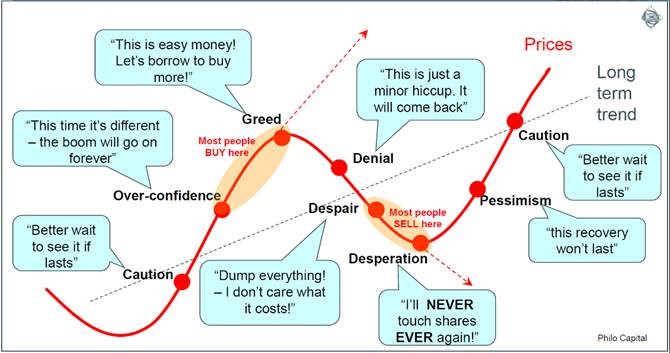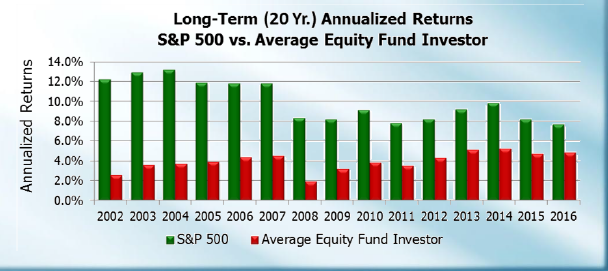Introduction
You might read the title of this blog and start yawning. It’s okay – you would not be alone. I like to gauge client’s interest of a subject based on my wife’s reaction when I ask her about the topic at the dinner table. Needless to say, behavioral finance was not a catalyst to fruitful dinner conversation this week when I broached the subject. With that being said, this topic is very important to the potential long-term success for our clients (and all investors) so we thought it helpful to explain in greater detail.
What is Behavioral Finance?
Behavioral finance is a relatively new field of study. The idea is to look at the reasons people make decisions surrounding investing and their money (those decisions are often irrational). Behavioral finance applies psychological theories to economics and personal finance. As you may imagine, the personal decisions that people make about their money have a dramatic impact on their personal finances (i.e. their standard of living) and also on the economy.
The Emotions of Investing
“When stocks go up, you never have enough. When stocks go down, you always have too many.”
This quote is true with every investor I have ever met. As investors, risk is defined by the change (or deviation) above or below the expected investment return. We have never received a client phone call complaining about the “risk” in their portfolio as markets moved higher. Investors typically only care about risk on the downside.
As markets decline, there may be a slow realization that a market falling is something more than an opportunity to “buy the dip”. As losses mount, investors can become overwhelmed until that individual may seek to “avert further losses” by selling.
As shown below, this behavioral trend runs counter-intuitive to the “buy low/sell high” investment rule that investors love to quote.

Why is Behavioral Finance Important?
“I am fearful when others are greedy and greedy when others are fearful.” – Warren Buffett
This is a very popular quote and most investors would say they agree with the logic but in practice this is very difficult idea to implement on a consistent basis. It is similar to me saying “I want to be healthy”. Everyone wants to be healthy but few people take the necessary steps to live a consistent healthy life.
DALBAR, a leading financial research firm, produces an annual report comparing stock market returns with average investor returns. Their study shows that over the last 30 years (through December 31, 2016), the S&P 500 stock index has produced an average annual return of 10.16%. However, over that same period, the average equity fund investor has earned only 3.98%.

Bottom line… if we know the tendencies of how investors behave, then we can be more aware of our shortcomings and make a conscious attempt to battle these destructive behaviors with the goal of enhancing long-term performance and keeping clients (or investors) on track.
Key Concepts to Consider Within Behavioral Finance
Herd Behavior – Following the crowd is nothing new. There have been many studies on this topic over the past 100 years. As a larger group does something — like buy a “hot” stock, or sell in a panic when the market drops — individuals tend to follow. Breaking herd mentality is one of the best things you can do for your own finances.
A great example of herd mentality was Bitcoin in 2017. It seemed like everyone was talking about it. We received countless questions from clients about this speculative investment. Yet 11 months after the peak, Bitcoin is worth about half of what it was at Christmas 2017. Following the crowd is most often the wrong thing to do.
Anchoring – This refers to a tendency to fixate on a particular piece of information while ignoring other information that may be just as relevant to the situation or decision making process.
For example, an investor may anchor on a previous portfolio value and then constantly compare the current value to that previous (usually higher) value. We see this frequently with how retirees look at their former company stock. They say… “Well I am just going to wait to sell my company stock until it gets back to $90 a share. It was at $90 awhile back.”
Belief in Being “Above Average” – Most people rate their intelligence as “above average.” Studies show that 92% of Americans think they are an “above average” driver. Most people see success as something that they caused; however, setbacks are blamed on external forces.
So, an investor might believe he or she is a stock picking genius when an investment performs well. However, when that investment moves lower, the same person blames the drop in value on “the market” or “the economy.”
Confirmation Bias – We are guilty of confirmation bias when we seek out information that supports what we already believe and ignore facts that are contrary to our belief. Confirmation bias is frequently seen in political arguments.
When it comes to investing, confirmation bias can cause us to act without considering all available information. For example, one might want to sell some of their stock allocation due to the current trade tension with China. One would look for data that agrees with their outlook on the trade dispute.
Loss Aversion – It has been well documented that the pain of a big loss lasts much longer than the excitement from a big win. When applied to investments, loss aversion explains an investor’s predisposition to avoid taking losses, even at the expense of sacrificing gains.
Some studies have suggested that losses are twice as powerful, psychologically, as gains. This unwillingness to accept losses often causes us to hold on to losing investments too long, hoping that someday the investments will bounce back.
Mental Accounting – This is the tendency of people to designate money for a certain purpose. For instance, they divide up money and treat it differently, depending what “account” it’s in. For example, some people keep a special “money jar” for a vacation or a new home while at the same time carrying substantial credit card debt.
Conclusion
There are many behavioral finance concepts that help explain irrational human behavior. Our goal with this blog post is to help our clients overcome these biases by being aware of them and adjusting their behavior to reflect more practical and rational behaviors with the goal of leading to better long term results.
We will remain vigilant and continue to focus on the economic fundamentals rather than letting dramatic headlines sway our long-term goals.
As always, please call us with any specific questions regarding your Live Well Plan or if we could be of assistance in any way.
The S&P 500 is an unmanaged index of 500 widely held stocks that is generally considered representative of the U.S. stock market. The Dow Jones Industrial Average (DJIA), commonly known as “The Dow” is an index representing 30 stock of companies maintained and reviewed by the editors of the Wall Street Journal. Indices are not available for direct investment. Any investor who attempts to mimic the performance of an index would incur fees and expenses which would reduce returns. The foregoing information has been obtained from sources considered to be reliable, but we do not guarantee that it is accurate or complete, it is not a statement of all available data necessary for making an investment decision, and it does not constitute a recommendation. Any opinions are those of Matt Price and Daniel Bingham and not necessarily those of Raymond James. DALBAR’S 2016 Quantitative Analysis of Investor Behavior (QAIB) study examines real investor returns from equity, fixed income and money market mutual funds from January 2016 through December 2016. The study was originally conducted by DALBAR, Inc. in 1994 and was the first to investigate how mutual fund investors’ behavior affects the returns they earn. The Average Equity Investor is calculated using results supplied by the Investment Company Institute. Investor returns are represented by the change in total mutual fund assets after excluding sales, redemptions, and exchanges. Results capture realized and unrealized capital gains dividends, interest, trading costs, sales charges, fees, expenses, and other costs. Past performance is no guarantee of future results. Indexes cannot be invested into directly. Raymond James is not affiliated with DALBAR. The prominent underlying risk of using bitcoin as a medium of exchange is that it is not authorized or regulated by any central bank. Bitcoin issuers are not registered with the SEC, and the bitcoin marketplace is currently unregulated. Bitcoin and other cryptocurrencies are a very speculative investment and involves a high degree of risk. Investors must have the financial ability, sophistication/experience and willingness to bear the risks of an investment, and a potential total loss of their investment. Securities that have been classified as Bitcoin related cannot be purchased or deposited in Raymond James client accounts.
